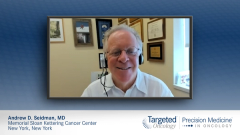
Minimizing the Risk of CIN in the Curative Setting
Recommendations for preventing and mitigation infection risk in patients with chemotherapy-induced neutropenia in the adjuvant setting.
Episodes in this series

Joyce O’Shaughnessy, MD: This conversation is most germane in terms of the clinical impact of chemotherapy-induced neutropenia in the curative setting. That’s what we’re going for. That’s where we hate to deviate from the standard-of-care doses and schedules because we know that if you don’t give good dose intensity, patients are going to have a worse outcome. We’ve known that for decades. In the metastatic setting in general, we can be a bit more careful. We can start a little lower and go up [in dosage] if we need to expect certain agents. Like sacituzumab, I don’t want to do that. I want to start the full dose because it’s got the survival impact. I’m reluctant, and neutropenia is a toxicity associated with it. How do we manage this, particularly in the metastatic setting? In the adjuvant setting, unless people have very obvious comorbidities that tip us off that we cannot start a full dose, the onus is on us to try to cure these patients. That’s where you have the highest stakes because a death related to febrile neutropenia or to sepsis is the most dreadful of possibilities. Unfortunately, these things happen.
Andrew D. Seidman, MD: Fortunately, I’ve been blessed—or lucky—not to have any deaths that I can recall from neutropenic complications in early breast cancer. The ones I remember were pneumonitis, and there was 1 patient who developed typhlitis, I believe. But going back to the days of Dr. William Herbenick with CMF [cyclophosphamide, methotrexate, 5-fluorouracil] and dose density, getting the intended dose in on time and on schedule—as a component of a curative regimen for early breast cancer at least—is important. That has made growth factors essential. When we give neoadjuvant chemotherapy, patients have to be fit by the time they’re ready to go to surgery in terms of having myeloid recovery or having adequate red blood cells to carry oxygen and platelets to allow for surgery to happen without bleeding risk. Patients also have postoperative risks. For example, with the patient who’s had mastectomy with reconstruction, there are wound-healing risks and a lot of other reasons that you need to minimize myelosuppression and avoid infections postoperatively.
Joyce O’Shaughnessy, MD: I always carry around the 85%. Dr. Herbenick had targeted 85% in terms of a dose intensity that needed to be met to get the full benefit. Below that was going to decrease outcome utilizing some of the old CMF [cyclophosphamide, methotrexate, 5-fluorouracil] data with long-term follow-up.
Andrew D. Seidman, MD: In my neighborhood, we probably don’t use as much TC [docetaxel, cyclophosphamide] as in your neighborhood, but we do use TC [docetaxel, cyclophosphamide]. But I know some docs give TC [docetaxel, cyclophosphamide] times 4 and some give TC [docetaxel, cyclophosphamide] times 6. I haven’t done TC [docetaxel, cyclophosphamide] times 6 a lot, but I hear sometimes getting those extra cycles in can be a challenge.
Joyce O’Shaughnessy, MD: TC [docetaxel, cyclophosphamide] is really myelosuppressive. You wouldn’t think necessarily you have to have growth factors, but I learned the hard way with multiple admission that you have to use pegfilgrastim with the TC [docetaxel, cyclophosphamide]. Docetaxel is a tough drug. It starts beating up the mucosa. Patients get increasingly poor performance status. [They become] very tired. It’s got cumulative myelosuppression as well. That’s a good segue into talking about the limitations of the tools we have in hand. We tend to use the pegfilgrastim in the curative setting. In the metastatic setting, it’s more filgrastim. Although there are variations, depending on dose and schedule.
Andrew D. Seidman, MD: We said the word limitations. You made me think about patients who say, “It’s great that this regimen has a very good chance of curing me of my cancer and never having a recurrence. But that’s not enough for me. I also don’t want to lose my hair.” Now we have scalp cooling. What we used to accept as inevitable no longer is inevitable with the use of cold caps and scalp cooling, depending on the regimen and the patient, of course. I guess the question is, do we need to accept that, despite growth factors, there’s going to be some not-trivial portion of patients who get into trouble, who are hospitalized, who need to have dose delays and dose reductions? It’s important to think about the potential for other agents that have novel mechanisms, not necessarily just myeloid growth factors, which can make a difference.
Transcript edited for clarity.













































